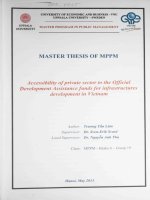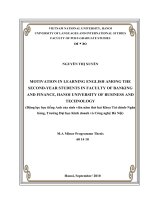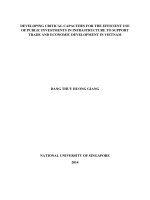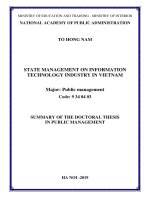The regtech technology development in the banking and finance sector in Vietnam 2022
Bạn đang xem bản rút gọn của tài liệu. Xem và tải ngay bản đầy đủ của tài liệu tại đây (1.73 MB, 50 trang )
THE STATE BANK OF VIETNAM
BANKING UNIVERSITY OF HO CHI MINH CITY
GRADUATION THESIS
THE REGTECH TECHNOLOGY DEVELOPMENT IN THE BANKING AND
FINANCE SECTOR IN VIETNAM
Major: FINANCE – BANKING
Supervisor: Dr. NGUYEN MINH NHAT
Student: HUYNH THI NGOC ANH
Student ID: 030805170278
Class: HQ5 – GE08
HO CHI MINH CITY - 2022
THE STATE BANK OF VIETNAM
BANKING UNIVERSITY OF HO CHI MINH CITY
GRADUATION THESIS
THE REGTECH TECHNOLOGY DEVELOPMENT IN THE BANKING AND
FINANCE SECTOR IN VIETNAM
Major: FINANCE – BANKING
Supervisor: Dr. NGUYEN MINH NHAT
Student: HUYNH THI NGOC ANH
Student ID: 030805170278
Class: HQ5 – GE08
HO CHI MINH CITY - 2022
RESEARCH GUARANTEE
I hereby declare that this thesis is my own research work. The thesis with the
topic " THE REGTECH TECHNOLOGY DEVELOPMENT IN THE BANKING
AND FINANCE SECTOR IN VIETNAM " was carried out by the author under the
guidance of Dr. Nguyen Minh Nhat. The research data in the thesis is compiled by the
author from many different reliable sources such as: State Bank, Vietnam science and
technology magazine.
Once again, I hereby declare that the content of the thesis published below has
not been made without unauthorized copying of anyone else's research. At the same
time, this thesis has never been published in any form or used to defend a bachelor's
degree at any university before. The author guarantees that the research results of the
thesis are independent and truthful.
I hereby declare and fully accept
Supervisor
The Author
Anh
i
ACKNOWLEDGMENTS
In the past time, thanks to the favorable conditions of Banking
University of Ho Chi Minh City, I would like to thank all the professors at
the university for having conveyed me a lot of useful knowledge and
experience over the past fouryears, especially Ph.D.Nguyen Minh Nhat - the
instructor who has wholeheartedly instructed me to complete this thesis well
Last but not least, I express my deepest gratitude to my parents for teaching
me everything that makes me who I am today. Furthermore, I am grateful to my
mother for her close support and encouragement throughout this study.
I wish you all health and success in the career of growing people.
Best regards
The Author
A
ii
PICTURE LIST
Figure 1: Need of RegTech ............................................................................... 2
Figure 2: RegTech investments over the years.................................................. 5
Figure 3: Some technologies supported by RegTech ........................................ 6
Figure 4: Benefits of reporting tools ................................................................. 7
Figure 5: Some benefits on the World ............................................................. 12
Figure 6: RegTech market segments – proportion RegTech solutions used by
Fis ................................................................................................................................ 16
Figure 7: RegTech solutions that financial institutions have experience with
and areas where RegTech providers offer their services ............................................. 17
Figure 8: RegTech market segments – proportion RegTech solutions offered
by RegTech providers .................................................................................................. 17
Figure 9: Year of RegTech solution going live first (left) and number of
financial institution clients ........................................................................................... 18
Figure 10: Main effects of using RegTech solutions ...................................... 21
Figure 11: The key reasons to implement Regtech ......................................... 22
Figure 12: The main reasons using RegTech .................................................. 23
Figure 13 : Learning machine .......................................................................... 25
Figure 14: Obstacles and operational challenges per RegTech segment ........ 33
iii
ABBREVIATIONS
AI
Artificial Intelligence
CEO
Chief Executive Officer
CFO
Chief Financial Officer
CIO
Chief Information Officer
EBA
European Banking Authority
EEA
European Economic Area
FLs
Financial Institution
Information & Communication
ICT
Technologies
IA
Internal Audit
RPA
Robotic Process Automation
AML
Anti – Money Laundering
CFT
Counter – Financing Terrorist
AISP
Account Infornation Service Provider
iv
TABLE OF CONTENTS
TABLE OF CONTENTS ......................................................................... v
ABSTRACT ............................................................................................ 1
CHAPTER 1 : OVERVIEW OF REGTECH ........................................... 2
1.1.
Rationale................................................................................................... 2
1.2.
Features of RegTech ................................................................................ 4
1.3.
Some kinds of RegTech products .......................................................... 5
1.3.1.
Report automation tools ........................................................................................... 6
1.3.2.
Robotic process automation ..................................................................................... 8
1.4.
The Difference Between RegTech, FinTech, and SupTech ................... 9
1.4.1.
Some basic things about them ............................................................................. 9
1.4.2.
RegTech is the regulator of Fintech ................................................................... 11
1.4.3.
RegTech can support your organization to achieve compliance ....................... 11
1.4.4.
Research results ................................................................................................ 13
CHAPTER 2 : THE REGTECH TECHNOLOGY DEVELOPMENT IN
THE BANKING AND FINANCE SECTOR .....................................................16
2.1. Effect of RegTech in the banking and finance sector: ............................. 16
2.1.1. Current RegTech landscape in the EU: ........................................................................ 16
2.1.2. Monetary Authority of Singapore (MAS) .................................................................... 19
2.1.3. Financial Conduct Authority (FCA) ............................................................................ 19
2.2. Challenges in using RegTech in Finance sector ...................................... 20
2.3. Technologies trends in RegTech development ........................................ 24
2.3.1. AI and machine learning for identifying and predicting risks in RegTech ....................... 24
2.3.2. Blockchain for automating compliance procedures: ..................................................... 26
2.3.3. The important role of regulatory bodies in the RegTech ecosystem: .............................. 27
2.3.4. RegTech firms must understand that that their role far exceeds technological innovation: 27
2.3.5. Regulatory Sandboxes as a Testing Ground for RegTech 3.0 ............................. 28
v
2.4. The RegTech
technology development in the banking and finance
sector
in
Viet
Nam………………………………………………………………………………29
CHAPTER 3 : PROBLEMS AND SOLUTIONS OF REGTECH IN
FINANCE SECTOR ........................................................................................31
3.1. Challenges of Using RegTech .................................................................. 31
3.2. Solutions for RegTech technology development in the banking in Viet
Nam ……………………………………………………………………………………………….36
3.3.
Conclusion…………………………………………………………………………35
REFERENCES .....................................................................................38
vi
ABSTRACT
The use of advanced technology in the financial sector continues at a rapid pace.
RegTech, is defined as any application of technology that supports innovation for
regulatory, compliance and reporting requirements performed by a regulated
organization (with or without support). RegTech provider support, potentially making
compliance more efficient in the financial sector.
Financial institutions using a RegTech solution highlight enhanced risk
management, better monitoring and sampling capabilities, and reduced human error as
key benefits of using the tools. Meanwhile, RegTech vendors highlight the ability to
increase efficiency, quell the impact of constant regulatory change, and improve
efficiency as key benefits associated with using our RegTech solutions.
However, RegTech solutions, if not implemented properly, can pose risks to FIs
that need to be identified, monitored and managed. These risks may relate to, for
example, compliance, centralization, business continuity, ICT and security, reputation,
internal governance, consumer protection, or technology . At the same time, RegTech
may present new risks to authorities monitoring FIs using RegTech solutions. In
particular, potential risks may arise when trying to assess the effectiveness and reliability
of the technology solutions used by FIs, and there may be a lack of skills and tools
needed to monitor technology. For example, use tech-enabled RegTech solutions when
trying to test underlying algorithms.
Therefore, a balanced approach is needed to acknowledge the benefits of RegTech
and create an environment that supports innovation, but at the same time close
supervision and a willingness to manage any associated risks
1
CHAPTER 1 : OVERVIEW OF REGTECH
1.1.
Rationale
Regtech concept
The Financial Services industry has long been full of regulations. In an effort to
reduce the growing burden of these regulatory provisions, financial institutions are
beginning to turn to new technology solutions. Around the world, regulatory changes in
the financial sector are accelerating at an astonishing rate. Dealing with the high volume
of new regulatory changes poses a high level of complexity and rigorous timelines for
financial institutions. Over the past decade, regulators have asked financial institutions to
undertake some of the modernization of their businesses, and many have struggled with
regulatory transformations. Regulatory Technology (RegTech) has established a strong
foundation in the FinTech ecosystem to overcome this and deliver solutions that target
new and complex regulations, litigation and remediation areas faced by financial
institutions (FIs), combined with an overall reduction in compliance costs. There are
more than 1600 companies worldwide, offering a variety of solutions and services to
help other businesses meet their compliance needs. Most of these companies help with
regulatory compliance like PSD2, MiFID II, 4MLD and GDRP.2 And most of these
RegTech solutions are available using open APIs and SaaS models.
Figure 1: Need of RegTech
Nguồn: Needs Of Regtech | FinTech Insights | PwC's Financial Services
2
Regulatory Technology (RegTech) means any application of a technological
innovation that supports regulatory, compliance and reporting requirements made by a
regulated organization (with or without RegTech provider support)
Article 31 of the European Banking Authority (EBA) Founding Regulation
mandates the Authority to promote supervisory convergence and facilitate entry into the
market of actors or products relying on technological innovation, in particular through
the exchange of information and best practices. The aim of this mandate is to contribute
to the establishment of a common European approach towards technological innovation.
In practice, it means that authorities need to monitor RegTech developments to be
aware of the benefits RegTech solutions can bring, develop a good understanding of any
risks emerging and ensure that regulatory and monitoring frameworks can capture and
mitigate those risks. Last but not least, the accumulated experience can be used to apply
innovation in the monitoring process when developing SupTech tools.
Rather than being viewed as a growing subcategory of FinTech, RegTech should
be viewed as a separate phenomenon. In contrast to FinTech's inherent financial focus,
RegTech has the potential to be applied in a variety of regulatory contexts. Capabilities
include monitoring corporations' compliance with environmental regulations and realtime tracking of the location of planes, two simple examples of how the technology
could be used to improve not only regulation but also the regulated industry itself.
Furthermore, the growth of FinTech and the growth of RegTech are underpinned by
different dynamics. FinTech's growth has been fueled by startups, which have capitalized
on public distrust in the financial services industry, commodity technology, and the
recent rise in jobless professionals. are looking for new ways to apply their skill sets.
Meanwhile, RegTech has emerged to fill a top-down institutional need arising from the
exponential growth of compliance costs.
The analysis of the RegTech market in the financial sector and the
recommendations contained in this report will form part of future policy discussions with
3
the broader goals of facilitating innovation and to support innovation and the goals of the
Digital Finance Strategy.
1.2.
Features of RegTech
First of all, a solution must be agile enough to take an even disorganized set of
information and combine it into a unified cluster using ad-hoc technologies. The large
share of FIs‘ reported ICT security‐related RegTech solutions may include ‗usual‘ ICT
security tools and compliance solutions
The second characteristic to consider when evaluating a RegTech system is speed.
Compliance management and verification solutions must be able to be implemented
quickly to minimize the time it takes to achieve maximum resource utilization. Regtech
solutions that financial institutions have experience with and areas where RegTech
providers offer their services
The third important feature is adaptability. Regardless of a company's structure
and the digital ecosystem it uses for its internal processes, automated compliance
management software must be able to integrate and work seamlessly with no additional
costs.
Last but not least, RegTech's implemented software should enable the efficient
and secure management of big data, so that it is easy to understand and use to improve
your business operations.
Finally, cloud-based RegTech systems ensure a high level of reliability and
security by ensuring that data is always accessible, even in the event of a sudden
shutdown, and provide encryption to protect data in transit.
-
Regtech brings some advantages itself that attract more and more investment:
-
Reducing time needed for client onboarding
-
Identifying the frauds
-
Adapting to new regulations faster
-
Improve data collection and data analytics
4
REGTECH INVESTMENTS (IN US$ MILLION)
1037,5
892,6
774,9
668,2
2017
2018
2019
2020
Figure 2: RegTech investments over the years
Nguồn: Needs Of Regtech | FinTech Insights | PwC's Financial Services
1.3.
Some kinds of RegTech products
It is important to develop powerful FinTech solutions with RegTech innovation to
create sustainable financial products with Security Management Automation.
FIs are complex legal structures, with many different business models, metrics,
and risks. RegTech enables FIs to internally control and be accountable for risk data,
compliance assessment, analysis, and effective policy and procedure management.
5
Figure 3: Some technologies supported by RegTech
Nguồn: Needs Of Regtech | FinTech Insights | PwC's Financial Services
1.3.1. Report automation tools
Existing legacy solutions used by banks are not suitable to meet the increasingly
stringent requirements implemented by regulators worldwide. RegTech is a seamless
way for banks to meet these requirements without having to completely overhaul their
6
existing models. RegTech is poised to be the future of helping with compliance
management and reducing regulatory risk.
Many banks have started to implement reporting automation tools to Reduce
reporting errors and improve efficiency. Such tools provides organizations with an
automated way of sourcing data, aggregate balances and create regulations reports
through a user-friendly tool.
Figure 4: Benefits of reporting tools
Nguồn: RegTech Book
7
Some benefits of reporting tools:
Speed up the reporting process. By automating reports, you dramatically
reduce the amount of time it takes to organize your data.
Generate reports with the exact parameters you need. Some of the best web
reporting tools allow you to customize your reports: choose the parameters
you need to measure and compare them to tailor the reporting process to
your business.
Find insights in raw data. Organizing your data allows you to quickly
discover valuable insights and execute them to achieve your business
goals.
Visualize reports or integrate with visualization tools. Visualization
software lets you go one step further than conventional table-based
reporting: create interactive charts and dashboards.
Improve decision making. Get reports based on essential information, share
them with your team members, and justify your decisions based on
accurate metrics.
Vendor automation tools offer a wide range of capabilities from simple report
submission and editing test functions to more complex data sourcing, aggregation, and
mapping capabilities. A number of niche solutions also exist to support end-to-end
reporting cycle-specific processes, such as risk calculation tools, predictive modeling,
and workflow management. Several reporting automation tools also benefit global
organizations by providing a single platform for consolidating and generating regional
reports. It should be noted, however, that in certain environments, a combination of tools
may be the best choice for pursuing end-to-end automation.
1.3.2.
Robotic process automation
RPA uses software to execute business processes in an iterative, tested and
controlled manner. This allows financial services organizations to automate highvolume, deterministic, existing computer-based tasks as if business users were doing the
8
work. Software-enabled robots operate 24/7, sit alongside existing IT infrastructure, and
are managed by IT and operations teams. Robotic tools in the RegTech space give users
the ability to reallocate time for analysis that might have previously been limited due to
the existence of manual processes. The ability to combine other automation technologies
such as machine learning and artificial intelligence (AI) with RPA increases efficiency
by creating a virtual workforce primarily capable of executing tasks, communicate, learn
from data sets, and even make decisions.
Financial services institutions have begun to leverage robots in operations and
other high-volume functions to perform tasks such as routine regulatory compliance
checks and monitoring, identifying failures and variance based on material thresholds
and automate other manual regulatory reporting processes. Progressive Internal Audit
(IA) departments in financial services are exploring opportunities to transition manual,
non-assessment, repetitive tasks to technology-enabled robotics. This transformation will
allow IA departments to augment testing (e.g., population-based versus sample-based).
Robotics has moved data and process monitoring from reactive to proactive, allowing
organizations to focus on issues in real time instead of leaving the company at risk.
1.4.
1.4.1.
The Difference Between RegTech, FinTech, and SupTech
Some basic things about them
The term financial technology (Fintech) refers to new technology that improves
and automates the provision and use of financial services. Basically, Fintech is used to
assist corporations, company owners and consumers to better manage their financial
activities, procedures and lives through the use of software and algorithms. Specialized
math is done on computers and, moreover, smartphones.
In general, the word "financial technology" refers to any advancement in the way
people do business, from the advent of digital currencies to double-entry accounting.
However, financial technology has developed rapidly since the internet and internet
revolutions/smartphones and fintech revolutions, originally belonging to computer
technology applied to the back Office of banks or commercial companies, now
9
belonging to a wide range of technological approaches to personal and commercial
finance.
Fintech today refers to a wide range of financial activities that can be performed
without the assistance of a person, such as transferring money, depositing checks using
your smartphone, bypassing a bank Office to apply for a loan, save capital to start a
business or manage your investments.
Also, RegTech solutions come in a variety of shapes and sizes. Business solutions
can be developed to provide a real-time 360-degree view of compliance and risk, while
single-rule solutions focus on a single area.
Compliance officers understand that regulation is not a black and white matter.
Financial regulators enable organizations to design compliance and risk management
strategies appropriate to their size and complexity. There is no such thing as a one-sizefits-all solution. The best RegTech solutions combine cloud-based automation
technologies with the expertise and services of regulatory experts with years of
experience analyzing regulatory complexity. Powerful RegTech solutions look at the big
picture, recognize and analyze the interplay of a variety of risks across the company to
improve efficiency. They also allow an organization to better understand regulatory
constraints, allowing the organization to direct resources to the areas that matter most
instead of employing a distributed strategy.
However, Supervisory technology, commonly referred to as SupTech for
regulators, refers to technology solutions that assist financial supervisors in managing
regulatory compliance. The supervisory body is responsible for risk management in the
financial sector and for implementing regulations.
Just as financial companies are responsible for complying with thousands of rules
and regulations, supervisors are tasked with ensuring that all those rules and regulations
are followed by financial institutions. SupTech provides technology tools for regulators
to improve efficiency through automation.
10
1.4.2.
RegTech is the regulator of Fintech
RegTech helps banks meet regulatory standards, just as FinTech helps banks
connect with customers through technology. RegTech uses a variety of technologies,
including machine learning and artificial intelligence, to build enterprise-wide data
governance and reporting. These new technologies are intended to replace current
manual methods of analysis and reporting.
With the ever-changing regulatory environment, RegTech improves the ability of
organizations to comply with important rules such as the Bank Secrecy Act (BSA),
including know your customer (KYC) and reporting and suspicious activity report
(SAR). RegTech also makes it easier to comply with data reporting requirements under
various laws.
RegTech, like FinTech, helps organizations manage their internal credit and
marketing standards. In contrast, FinTech helps them comply with government
regulatory standards issued by several agencies, including the Federal Reserve Bank.
1.4.3.
RegTech can support your organization to achieve compliance
The time of the customer is cut in half, and the dangers can be made from money
washers and terrorist groups identified. The digitization of the KYC process has led to
consistent law compliance, because this process is less effort and time consuming.
Regtech applications can lead to lower fines and legal costs. Moreover, with less
complimental violations, financial institutions will lower the ability to harm reputation
connected to data or network violations caused by inadequate compliance monitoring.
Regtech enables financial firms to monitor regulatory developments in real time,
allowing them to adapt to new regulations more quickly. As a result, changes to internal
rules can be rolled out across the enterprise in a fraction of the time it would take to do it
manually.
RegTech strategies can help improve data analytics. Through data analytics,
organizations can develop a more detailed picture of their customers' financial history,
both internally and externally. RegTech reduces regulatory reporting processes. Just as
technology apps improve the efficiency and speed of reaching new customers, they also
11
improve the efficiency with which suspicious activity is reported to authorities. Financial
and criminal threats are recognized and reported faster due to the use of advanced
technology. RegTech assists in monitoring suspicious and fraudulent activities, such as
money laundering and terrorist financing, as soon as they are detected. Thus, RegTech
assists financial institutions with early detection.
As a Regtech, the Punishment Scanner helps financial institutions comply with
the rules and regulatory frameworks defined by local and global regulators. If you want
to comply with those laws and learn about our solutions, you can request a demo and
contact us for more details.
Figure 5: Some benefits on the World
12
Nguồn: RegTech Book
1.4.4. Research results
This report provides an overview of the current context, outlines the basics of
RegTech and its advantages over traditional banking and financial activities.
The RegTech sector has undergone a major transformation in recent years and
therefore the benefits, challenges and risks involved need to be understood to pave the
way for the use of technology for compliance purposes under technology-neutral way,
not advocating any particular solution, but also avoiding inadvertently impeding the
rollout and scaling up of innovation.
RegTech offers many benefits to organizations operating in regulated industries.
While we have addressed some of the barriers to adoption, the opportunities offered by
the adoption of innovative technologies that can aid in meeting organizational regulatory
requirements are substantial. The way in which RegTech is supported and integrated into
the existing regulatory structure will play an important role in navigating both the
development and implementation phases. Developers of RegTech solutions should seek
to engage directly with regulators and leverage regulatory sandboxes to aid in ensuring
compliance. With a careful and thoughtful integration into the current regulatory
environment, RegTech shows great promise in reshaping the way companies interact
with a growing regulatory watchdog.
RegTech as a Service encourages FIs to see RegTech as a way to improve work
processes for efficiency and regulatory compliance. In 2018, RegTech will begin to
rapidly expand in new directions, supported by its growing strength in capturing and
analyzing a multitude of internal and third-party data sources, using advanced techniques
of mass storage and artificial intelligence in the cloud with vendors combining both
technology expertise with specialized domain and data analytics skills to gradually
deliver 'RegTech as a Service'.
13
FIs can work with RegTech vendors or with regulatory consulting firms to
develop comprehensive solutions and address issues related to different compliance
teams. Any RegTech that can add information to data and reduce manual effort is a
prime target for use in financial institutions. Finding effective ways for a technology
solution to be understood, approved, and implemented is part of the puzzle that needs to
be solved as soon as possible. For example, online identity verification solutions can
provide access to many independent and trusted data sources, such as government
records, utilities, and credit files. The different types of partnerships are illustrated
below.
In a nutshell, RegTech's direct use cases for FIs:
One key growth area is regulatory reporting automation. Regtech intends to solve
problems caused by multiple data sources, systems, and errors arising from manual
review. A regtech solution that can search multiple data sources and compile
comprehensive, coherent and standardized reports. This not only saves banks
considerable time and effort, freeing up people's time to focus on tasks with higher skill
and value, but standardized reporting also makes analysis much easier for regulatory
agencies.
Regtech solutions can be used to verify identity in accordance with regulatory
requirements (such as KYC) while cutting out manual processes and flagging checks for
exceptional review only . This makes the whole process more streamlined, benefiting the
bank and the customer.
Big data analytics - including through open application program interfaces (APIs)
and using solutions developed under different regulations - provides the opportunity for
banks to gain a holistic view more about their customers. This allows banks to
demonstrate that they have taken the appropriate steps to identify risks and make
appropriate decisions for their customers.
14
A startup providing a financial news feed powered by Machine Learning. The
feed filters out irrelevant stories to ensure only the most popular and impactful articles.
One of the startups that has implemented a social media customer-compatible
communication innovation in a regulatory compliant manner for financial companies
RegTech certainly holds promise in the face of increasingly complex regulations.
FIs need to develop a proactive RegTech strategy and develop financial institutions
towards the implementation of holistic models, designed not to respond so much to
proposed regulations but to help banks and other financial institutions establish and
maintain a competitive advantage.
Chapter 1 Summary
RegTech enables FIs to comply with regulatory requirements more efficiently and
effectively. They actively work with new and evolving regulations and understand the
contingencies, creating powerful solutions by working on the Regulation ecosystem.
Regtech operates in many different areas of the financial and regulatory space. Some of
the regtech automation projects include employee monitoring, compliance data
management, fraud prevention, and audit tracking capabilities.
15
CHAPTER 2 : THE REGTECH TECHNOLOGY DEVELOPMENT IN THE
BANKING AND FINANCE SECTOR
2.1. Effect of RegTech in the banking and finance sector:
2.1.1. Current RegTech landscape in the EU:
Based on a sample of financial institutions (FIs) and RegTech providers surveyed,
the most frequently used RegTech solutions are related to AML/CFT, but also there is a
wide range of RegTech solutions available in the market. The survey responses provided
by FIs show a balanced coverage of RegTech solutions across the areas covered.
RegTech solutions in the area of AML/CFT are followed by RegTech in ICT security,
fraud prevention, security reporting and credit rating. This can indicate relative
prioritization of the areas where technology-based innovations can deliver the most
significant value.
Figure 6: RegTech market segments – proportion RegTech solutions used by Fis
Nguồn: EBA
However, the majority of RegTech solutions related to ICT security consist of
ICT security tools and compliance solutions, which may account for a high percentage of
use cases here because the Using technology in this area is very common. Data from a
recent EBA Risk Assessment also shows that the distribution of RegTech solutions used
16
by FIs is close to that of the RegTech vendors below, with security-related RegTech
solutions ICT is among the least used solutions.
Figure 7: RegTech solutions that financial institutions have experience with and
areas where RegTech providers offer their services
Nguồn: EBA
Figure 8: RegTech market segments – proportion RegTech solutions offered by
RegTech providers
Nguồn: EBA
17









